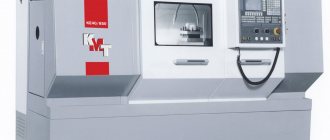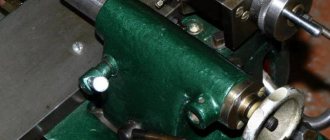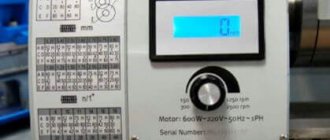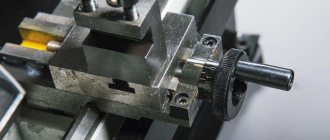20.03.2020
- Purpose and description
- Varieties
- How does a lathe work and what does it consist of?
- Diagram of a lathe with all the main devices
- What does a lathe do and how does it work?
- Operating a lathe: how to turn on the device and start working
- How to install and configure a lathe
- How to choose a metal lathe and make out the markings
Turning is one of the most popular and in demand metalworking methods. In this article we will tell you about the design of a universal metal lathe, what kind of equipment it is, what technical characteristics it has, how to choose and install a suitable one and carry out processing on it, as well as about its types.
Purpose and description
In fact, any enterprise that works with steel has a unit in its workshop that is capable of turning the necessary elements, for example, shafts, from a cylindrical workpiece.
The design itself is used not only for working with metal products, but also with other materials. The first progenitors of the installations were created back in the 7th century BC. They were used primarily for wood or bone and had a primitive processing mechanism: a wooden frame, not the most durable clamps and a manual drive. However, the essence of the operation remained the same.
And only at the beginning of the eighteenth century the first models appeared, which were intended for work in workshops with metal blanks.
Now modern devices have an electric drive, a strong base, and a durable tool made of tool steel. Some machines are equipped with numerical software, that is, they have a high degree of automation.
The essence of the metalworking operation is as follows. The raw material is clamped on both sides with special clamps. The spindles begin to rotate, and along with them, the workpiece itself begins to move. Then the tool begins to move. It has several axes - guides, depending on the modification of the equipment. Let's see what the lathe looks like in the image:
Various tools are then used. The cutter removes the top layer from the surface, performing the main operation - turning. Universal devices also additionally have the ability to make holes and apply threads.
Let's consider what purpose this unit has. It performs the following functions:
- ● production of screw-cutting taps and dies - you can make a full-fledged bolt or self-tapping screw from a rod;
- ● creating a cone - full or truncated, solid or hollow;
- ● reaming holes - blind or solid, their subsequent grinding, various processing;
- ● trimming edges, end parts;
- ● cutting one element into two or more.
Universal units have the maximum range of functions. However, the classic old model can only perform few tasks. The main thing is to remove the top layer of metal from a cylindrical workpiece.
How to become a metalworking professional
Training in turning, as, for example, in the profession of a doctor, lasts a whole life, in addition to a significant amount of theoretical information, books and practical skills that need to be mastered, there is a constantly updated fleet of equipment that requires study, lathes are developing. The range of processed materials is also increasing, and new composite and polymer materials with unstudied properties are appearing.
Download turning tutorial
Lessons in turning and metal processing from more experienced colleagues and teachers can help in mastering the profession. Now a library of technical literature on metal processing has become available on the Internet: reference books, turner’s manuals and textbooks. Additional education requires time, which is always in short supply, and money, which will also not be superfluous, but these costs will more than pay off in the future.
Types of lathes
Products are classified on several grounds. The main features and characteristics can be understood from the markings. Let's consider what criteria are fundamental when choosing.
Lathe accuracy class
Everything here is extremely simple. The better the tools are sharpened and the drawing is verified, the more accurate the result will be. But there is a noticeable difference between a manual and an automated process. Equipment equipped with CNC has a great advantage over manual labor. This is especially true for small details.
The letter included in the marking characterizes the accuracy class. We present them in ascending order from normal to especially high in this table:
| Designation | Permissible error in percentage | Manufacturing complexity, % |
| N | 100 | 100 |
| P | 60 | 140 |
| IN | 40 | 200 |
| A | 25 | 280 |
| WITH | 16 | 450 |
Weight
Any metalworking equipment has a significant weight. In most cases, additional reinforcement of the floors is required, for example, pouring a concrete base. Typically, such heavy structures are placed on the ground floor.
What can be done on a lathe, that is, what to work with, depends on what class the unit belongs to. Small units will handle small parts well. But if the question is about processing for mechanical engineering purposes, then it is often not enough. Let's see in a small table what varieties are distinguished:
| Name | Maximum weight (tons) |
| Easy | up to 1 |
| Average | from 1 to 10 |
| Heavy | more than 10 |
| Unique | above 100 |
Degree of automation
The more automated the machine is, the less physical labor the employee must use. The turner experiences less impact on his health at work, since he does not have to constantly experience fatigue, as well as the influence of high noise levels.
The second advantage of automatic machines is the acceleration of all processes and increased productivity. This is especially true for mass production, when all production is put on an assembly line.
The third benefit is a reduction in errors and an increase in accuracy. Usually, any errors and defects are the result of erroneous actions of the turner. The absence of costs for defective workpieces will help to save significantly. Let's look at how to work on a metal lathe, depending on the degree of automation:
- ● Manually controlled. The drive of two main movements (rotation and feed) is mechanized. But moving the tool, installing the workpiece, fixing it, removing chips, supplying lubricant - all this must be done manually.
- ● Semi-automatic. All of the above procedures are computer controlled. The exception is mounting and removing a part.
- ● Automatic The most advanced models, they are mostly equipped with a CNC control panel. The operator has sole control over the independent operation of the machine.
A wide selection of automatic installations is presented in the Sarmat online store. Their use will be economically beneficial not only in large factories, but also in small small-scale production.
System flexibility
There are classic machines, and there is a GPU, that is, a flexible production module. The second is different in that you can quickly and easily reconfigure the purpose of the work. That is, moving from one cycle to another. This is beneficial when there is a whole series of products with different standard sizes in production.
Special purpose in metal processing
There are a number of machines that have unique capabilities. They are used exclusively for one operation, but perform it with the highest quality and precision.
Versatility
What can be done on different types of lathes depends on multitasking. Universal devices have many tools and also have the ability to move the caliper in many directions. Classic units have only two axes of movement, while there are up to 6 directions.
Almost all CNC products make it possible to perform many tasks, including screw cutting, all of which are presented above.
Older models are usually not equipped with a control panel and have a narrow focus. Modernization in production often involves replacing outdated designs with more versatile ones. This allows not only to speed up the production process, but also to reduce labor costs, in some cases, jobs, since now with new devices many actions can be performed by one operator in the same time.
Typical Tool Parameters
The parameters and technical capabilities of machines for home use are largely limited by their compact size and low cost of the tool. Thus, the average price of a compact device is several tens of thousands of rubles; to purchase an industrial design, you will need at least several hundred thousand rubles.
The main characteristics of metalworking lathes are:
- workpiece diameter. The maximum value for compact models reaches approximately 140 mm;
- workpiece length. Usually does not exceed 250 mm;
- cutting height. The parameter determines the range within which the cutting part of the tool can be moved;
- maximum spindle speed. The time it takes to process one part depends on this characteristic. The higher the rotation speed of the workpiece, the faster the work can be completed. A typical value for a home tool varies between 2000-3000 rpm;
- number of speeds. Different types of materials, types and shapes of surfaces require a certain intensity of processing. If you grind or cut a part at a speed greater than that required by the technology, the metal will overheat and, as a result, become deformed or become less durable. Thus, the greater the number of speeds for a particular machine model, the higher the number of possible options for processing the material. Some devices allow smooth rather than stepwise rotation adjustment.
How does a lathe work and what does it consist of?
The design of all installations includes the following components:
- ● Bed. This is a metal base that supports the entire weight of the remaining elements, as well as the workpiece. All other parts are also attached to it.
- ● Apron. Responsible for converting energy into movement.
- ● Grandmas. There are two of them - one is simply responsible for fixing, the other includes a motor and a spindle that holds and simultaneously rotates the workpiece.
- ● Support. He is responsible for the tool - its movement and fixation.
- ● Feed box and other elements that allow you to change the speed and direction of movement of moving units.
- ● Numerical control panel, which, in turn, includes a display, a cabinet with buttons and the program itself.
These are the main parts, but there are also additional systems, for example, the supply of lubricating and cooling fluid or the removal of chips.
General equipment structure
Almost all lathes are based on a metal platform - a bed, where functional elements and auxiliary devices are located. It is immediately necessary to divide the entire segment of this equipment into floor-standing and table-top units. Accordingly, the former are installed on the floor and fixed with screws to the foundation base, while the latter are small in size and can be attached to workbenches of a suitable size. In some versions, desktop lathes for the home allow the optional installation of metal legs to extend the bed. This approach is used in cases of processing workpieces of non-standard shape.
The standard design also includes a headstock, which houses the power mechanics. This part contains the spindle, gearboxes and gearboxes, torque transmission mechanisms, etc. To convert the return movement into a forward movement, a special apron is provided, and the force is transferred to the cutting bodies for their movement by the caliper. The functional set of cutting, drilling and grinding tools depends on the specific design of the machine.
Diagram of a lathe with all the main devices
After the verbal description, let's look at the actual drawing of the product:
In the image we see a universal device, which is equipped with the ability not only to perform turning, but also to cut threads.
Here is another schematic photograph of a real unit:
On it we see, in addition to the main and secondary components:
- ● Front and rear cabinets. This is the element of the frame that bears the main load. When designing, the surface area is also taken into account. Their second task is to provide sufficient height for comfortable work of the turner.
- ● On the apron there is a wheel and a handle for moving the longitudinal and transverse slides.
- ● There are also screws for fixing on the tailstock.
- ● In the middle we see a movable block, which is equipped with a handle for attaching the tool holder and a tightening head - this is where the tool is installed.
What does a lathe do and how does it work?
The operating principle of the equipment is quite simple. The electric motor generates a supply of energy, which in the gearbox is converted into a force of movement - rotation is transmitted to the spindle or faceplate. These elements cause the workpiece to rotate.
At the same time, the caliper begins to move. Regardless of the level of automation, there are horizontal and vertical devices. This affects which axis of tool movement is the main one.
Thus, there are only two movements - rotation and serve. The operator directs the support to the desired location. The cutting part removes the top layer from the metal surface and chips are formed.
Features of the operational process
The work process consists of several stages, the main ones being setting up the machine and installing the workpiece. As for the settings, it is performed manually or automatically - again, it depends on the way the specific model is controlled. To fasten the workpiece, a regular home lathe has special clamping equipment with guides. To securely grip wooden elements, gear devices or faceplates with holes are often used. Next, all that remains is to configure the processing parameters with the rotation speed and put the unit into operation.
Operating a lathe: how to turn on the device and start working
First you need to install the workpiece in two spindles and check the reliability of the fastening. If one of the holders flies out of its place at high speed, serious consequences are possible, both for the equipment and for the engineer. The second stage is the selection and installation of the tool. For classic tasks, cutters are used; sometimes drills or taps may be needed (when drilling holes and applying internal threads). In CNC-equipped equipment, both of these operations are often performed automatically. On semi-automatic machines this is done by the operator.
Further actions may vary depending on the type of machine.
On automatic:
- ● Develop a project, enter data into the control system.
- ● Turn on the lathe.
- ● Monitor the correct execution of the procedure.
For manual production:
- ● Turn on the engine.
- ● Using the gearbox, select the optimal number of rotations per second.
- ● Use the handles and wheel to control the movement of the caliper, cutting off the desired size of the top layer.
Also, control measurements should be carried out at different stages. Then you can sand it.
About metal processing and metal cutting machines
Anyone who tries to do anything with their own hands faces this task and the subsequent problem of metal processing. Metalworking tasks are relevant both for home craftsmen and small workshops, as well as for large machine-building plants. True, their solutions to these problems are different, and metal-cutting machines play the most important role in this solution.
Any tool, machine, device designed to change the shape, size, parameters of a metal part belongs to the class of metalworking machines. Metal cutting machines process metal by cutting, and this is different from grinding, drilling, polishing, bending, chopping, and sawing metals.
A metal-cutting machine is a metal-working machine, with the help of which, using metal cutting technology, it is possible to create a metal part of the desired shape and size. The part will have specified parameters for the accuracy and quality of the machined surface.
How to install and configure a lathe
First you need to choose a suitable location. This should be the first floor (or reinforced ceilings should be used in advance). The floor can be earthen or concrete. The room itself must have:
- ● good ventilation;
- ● bright lighting;
- ● fire safety measures.
When working with large-sized elements, the workplace should be equipped with a lifting mechanism, as well as a driveway - rails are often installed. For small parts, it is necessary to equip a separate cabinet to accommodate them. You will also need an area for tools.
The thickness and type of foundation depends on the weight of the equipment. The base can be local (pouring a small layer of concrete directly under the frame) or general, when ties and bolts are required.
Setting up the unit must be carried out by specialists. Without confidence in the performance and safety of the product, switching on is not recommended. not only deals with the sale of professional equipment for metalworking, but also configures all important systems.
This image shows the installation of the unit on a concrete floor:
How to choose a metal lathe and make out the markings
When purchasing, you need to consider:
- ● Production needs. For small-scale and exclusive work, universal devices that can be reprogrammed are needed.
- ● Plant type. Depending on the size of the parts being processed (mechanical engineering or the creation of small elements), different types of machines will be required in terms of weight.
- ● Workshop premises. Sometimes it is more convenient to install vertical units instead of horizontal ones - they take up less space, but are not suitable for all workpieces.
- ● Cost. The higher the accuracy class and the more functions, the more expensive the device is. We do not recommend taking used devices, as they can simply be damaged by improper handling. And repairs will cost more than buying a new one.
Pay attention to the labeling. It provides all the necessary information and special technical characteristics.
A wide range of products is presented in the catalog of the Sarmat online store. The company sells metalworking equipment with a numerical control panel. Here you can buy equipment of different price segments with high accuracy.
In the article, we tried to explain everything about universal lathes and how to cut threads on them, process metal, and make holes. Follow safety precautions when working.
Additional selection criteria
After studying the seller's catalog, you can note several models with similar characteristics and functionality. The following criteria help you make your final choice:
- manufacturer. The bulk of lathes presented in Russian stores are domestic instruments, as well as devices manufactured in Europe and China. The products of European companies are of the highest quality and reliability, but are expensive. Russian and Chinese machines represent a reasonable compromise between price and capabilities. They are quite reliable and suitable for solving many typical problems;
- warranty and service. Even the most reliable tool sometimes breaks. A fairly large and heavy device cannot easily be sent by mail to another city or country. You should also pay attention to the availability and cost of components;
- additional options. Some machine models are equipped with devices that do not directly affect the functionality of the device, but significantly facilitate the processing of parts. These options include work area illumination;
- reliability of operation. In some cases, outstanding technical characteristics do not correspond to the actual operation of the device. If the seller offers to personally test the machine in action and thereby demonstrate all the capabilities of the model, you need to take advantage of this opportunity. The tool must work stably in all modes. In this case, there should be no extraneous vibrations or noise.
A lathe is an indispensable tool for the home workshop. Tools intended for household use are cheap and compact in size, but at the same time quite functional. They allow the same operations with rotating metal parts as their industrial counterparts.









